

By: S. Munir Alam, PhD

https://medicine.duke.edu/faculty/s-munir-alam-phd
Therefore if the posterior medial nook is damaged purchase 500mg valproate with amex, the cruciate ligaments cease the instability effective valproate 500mg. Newer analysis signifies that it takes 4000 N to order valproate 500 mg with amex rupture the patellar tendon graft buy 500 mg valproate with mastercard. The pressure is highest at 20 degrees of knee flexion (beginning at 45 degrees) and diminishes to little or no pressure at full extension, when the quadriceps compresses solely the tibia and femur. Complete rupture of the medial compartment ligaments with 1+ or 2+ anterior medial rotary instability heals to almost regular stability with out surgical intervention. Other grafts used to lesser degrees are bone-patellar tendon-bone autografts, hamstring tendon autografts, quadriceps tendon autografts, and anterior/posterior tibialis allografts. Testing for medial knee instability in a ten-year-old boy after a valgus damage demonstrates a pathologic opening of the medial compartment utilizing a valgus stress take a look at. Holm I et al: Effect of neuromuscular training on proprioception, balance, muscle strength, and decrease limb perform in feminine athletes, Clin J Sports Med 14:88-94, 2004. Margheritini F et al: Posterior cruciate ligament accidents within the athlete: an anatomical, biomechanical, and clinical evaluate, Sports Med 32:393-408, 2002. Most surgeons advocate resurfacing the patella, particularly within the presence of patellar chondro malacia, rheumatoid arthritis, and obesity. Some research have proven decreased ache and improved extensor mechanism strength in nonresurfaced compared to resurfaced teams. However, several authors have documented persistent anterior knee ache requiring repeat operation for patellar resurfacing following knee arthroplasty. Many patients are placed right into a knee immobilizer or a hinged knee brace locked in full extension instantly following surgery. The brace is used to facilitate terminal knee extension movement and to assist the knee during weight-bearing activities. The determination to remove the brace or unlock the hinges and permit movement is usually left to the therapist. Factors corresponding to out there knee vary of movement and quadriceps control must be thought-about when weaning the patient from the brace. Some authors advocate minimal or no bracing after surgery if quadriceps control is sweet and the patient can keep full extension vary of movement instantly following surgery. What is the load-bearing status of most patients following whole knee arthroplasty? Uncemented parts usually depend on bone ingrowth into the component, which usually is present to a point within 6 weeks following surgery. For this purpose, patients with uncemented parts usually have a restricted weight-bearing status during this period, most commonly 25% to 50% of full weight-bearing. The amount of knee flexion needed to perform various activities of day by day living has been proven to vary from 50 degrees whereas strolling, to eighty to 90 degrees for stair-climbing, to one hundred to a hundred and ten degrees for activities corresponding to rising from a chair or tying a shoe. Most orthopaedists consider 105 to a hundred and ten degrees one of the best long-term aim for knee flexion that will optimize patient perform. Describe a standard progression of strengthening exercises following whole knee arthroplasty. Patients usually begin a program of isometric exercises for the quadricep, gluteal, and hamstring muscles on postoperative day 1. Once the power to recruit the usually-silent quadriceps muscle is evident, patients begin short-arc quadriceps isotonic exercises. The patient is allowed to begin lively assistive and lively knee flexion and extension exercises during the inpatient setting. Resistance within the type of ankle weights or a Thera-Band is usually carried out earlier than discharge as properly. It is important to incorporate strengthening exercises of the hip and ankle musculature into the rehabilitation program. Patients must be comfortable in performing these exercises on their own at the time of hospital discharge. How do you know when a patient is able to be weaned from the knee immobilizer or brace whereas ambulating? The capability to perform a straight leg increase with no extensor lag often signifies sufficient quadriceps strength to control the knee whereas ambulating. For most patients that is present between weeks 3 and 5 postoperatively with sufficient rehabilitation. What are the indications for manipulation of the knee joint for movement following whole knee arthroplasty? In common, manipulation is reserved for the most recalcitrant cases of vary of movement restriction following knee replacement. Patients with an lack of ability to obtain full extension are usually braced in extension as a lot as possible, and remedy is targeted accordingly, including aggressive patellar mobilizations as soon as the postoperative dressing is eliminated. Manipulation is commonly performed from the second week to the three-month postoperative interval as the delicate tissues continue to mature. Some research have proven that patients are inclined to return to premani pulation movement within the long-term. Physical remedy is targeted upon quick aggressive vary of movement exercises to hold the gains in vary of movement obtained at the time of manipulation. An enhance in calf swelling, calf ache with dorsiflexion of the ankle, calf tenderness, and/or erythema are all potential signs of deep vein thrombosis and may prompt the therapist to 578 the Knee contact the physician as soon as possible. Rates of postoperative deep vein thrombosis, regardless of preventive remedy, vary from 10% to 57% of patients following whole knee arthroplasty, whereas the incidence of fatal pulmonary embolism in unprotected patients is simply 0. Posterior cruciate substituting techniques require removal of both cruciate ligaments at the time of surgery. Knee stability is obtained by way of a design that allows the tibial intercondylar eminence to articulate inside the femoral intercondylar field during knee flexion, thus stopping posterior translation of the tibia in relation to the femur. Posterior cruciate retaining designs spare the posterior cruciate ligament, allowing the ligament to retain its practical functions. Posterior cruciate retaining gadgets have the theoretical advantage of sustaining the proprioceptive perform of the ligament. Additionally, posterior femoral rollback facilitated by the posterior cruciate ligament during knee flexion potentially allows larger knee flexion vary of movement and improves the mechanical advantage of the quadriceps mechanism. One research has proven improved knee kinematics whereas ascending stairs in patients with posterior cruciate retaining knee replacements versus those with substituting designs. Proponents of posterior cruciate substituting designs cite larger ease of surgery, the larger capability to right deformities, and, most importantly, potentially decreased polyethylene put on rates as benefits of these designs. Because of the uncommon stories of posterior knee dislocation in cruciate substituted knees, some research advocate avoidance of resistant hamstring strengthening in positions of utmost knee flexion. Peroneal nerve palsy is a serious complication which will have everlasting consequences upon ankle strength and control. The prevalence of peroneal nerve palsy after whole knee arthroplasty has been reported to be round 0. The extensor mechanism is the most typical source of continued publish operative knee ache and can be related to patella fracture, patellar monitoring problems, parapatellar delicate tissue impingement, and failure of patellar parts. Infection is a dreaded complication following whole knee arthroplasty, with reported rates of 1% to 5% depending upon the patient population. Risk components embrace revision surgery, delays in wound therapeutic, pores and skin ulcers, rheumatoid arthritis, and, in some research, urinary tract infections and diabetes mellitus. Early infections can generally be treated with debridement and antibiotics whereas later infections often require removal of parts. Most clinical research following whole knee arthroplasty report survival rates between eighty% and 95% for Total Knee Arthroplasty 579 the tibial and femoral parts at 10 to 15 years comply with-up. Up to 94% survival rates of tibial and femoral parts at 18 to 20 years have been reported following cemented posterior stabilized whole knee arthroplasty, with total survival rates of 90% when patellar revisions have been included. Walking speeds for patients with whole knee arthroplasties have been discovered to be thirteen% and 18% slower at regular and quick speeds, as compared to topics with out knee pathology. Stair-climbing was compromised by 43% to 51% with patients following whole knee replacement as compared to other topics. Men with whole knee arthroplasty have been 37% to 39% weaker and women have been 28% to 29% weaker in their knee extensors as compared to healthy individuals. Unicompartmental knee replacements are less invasive, protect the bone stock, are more cost-effective, and have sooner restoration times. Patients have proven a lack of torque of approximately 30% in extension and flexion at 60 to 180 degrees/sec of isokinetic testing compared to individuals with out knee pathology. Unicompartmental knee replacements also protect regular knee kinematics, which are signi? Progression of arthritis to the lateral compartment may end up from slight overcorrection into valgus, and higher outcomes are discovered when the knee is slightly below corrected. It has been discovered that impartial to slight valgus is the optimal alignment for unicompart mental knee arthroplasty for anterior medial osteoarthritis. Two research discovered that 64% and eighty two% of topics examined have been capable of kneel after a minimum of 6 months following surgery with minimal to no ache (rated 0 to 4 out of 10). Forces by way of the femoral component are related in kneeling as compared to those of strolling and standing. Scar ache and again-related problems have been also components in limiting kneeling capability. Two topics within the research needed revision but they have been also playing 5 times a week, whereas the remainder of the themes have been playing roughly 3 times a week. Surgeons advice for return to golf was roughly 3 months, and to begin slowly. Does following an exercise program earlier than whole knee replacement surgery enhance end result? It was discovered that preoperational levels of ache and performance are one of the best predictors of ache and performance at 6 months following surgery. Implementing a strengthening program earlier than surgery did enhance patients common con? This design increases articulation conformity, decreases polyethylene put on, and minimizes the shear stress at the tibial Total Knee Arthroplasty 581 tray-bone cement interface. Rotating platforms provide unlimited axial rotation but with restricted anterior, posterior, medial, and lateral translation of the femoral polyethylene insert. Dislocation rates are greater in those patients with a preoperative valgus deformity and larger age at surgery. There has been no superiority discovered from a cellular-bearing rotating platform whole knee replacement as compared to a? Fuchs S et al: Muscle strength in patients with unicompartmental arthroplasty, Am J Phys Med Rehabil eighty three:650-654, 2004. Effects of tourniquet release and steady passive movement, J Bone Joint Surg 73A:1037-1040, 1991. Naudie D et al: Medial unicompartmental knee arthroplasty with the Miller-Galante prosthesis, J Bone Joint Surg 86A:1931-1935, 2004. Walsh M et al: Physical impairments and practical limitations: a comparison of individuals 1 year after whole knee arthroplasty with control topics, Phys Ther 78:248-258, 1998.
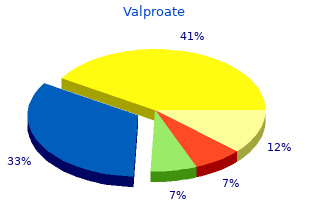
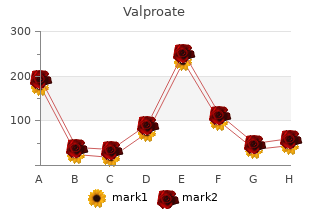
Intramural benign gastric tumors order valproate online now, 290?293 Isolated polycystic liver illness order cheap valproate line, congenital hepatic fibrosis related abnormalities cheap valproate 500 mg without prescription, 291 vs discount valproate express. See Hamartomatous polyposis Intraperitoneal fluid, free, after open laparotomy or syndrome. See Hepatic opportunistic a number of hypodense liver lesions, differential an infection. Liver resection, lobar regeneration after: hepatomegaly postoperative adjustments, 744?747 vs. See Intestinal regional, duodenal metastases and lymphoma metastases and lymphoma. See Splenic congenital abnormality, intestinal lymphangiectasia metastases and lymphoma. See Biliary neoplasms, Mediastinal tumor, intramural benign esophageal tumors malignant. See Colon neoplasms, Mediastinitis, fibrosing: superior vena cava obstruction malignant. See Hepatic neoplasms, Mesenteric adenopathy, complication of small intestine malignant. Mesenteric mass (solid), differential prognosis, sixty seven teratoma, hepatic angiomyolipoma and lipoma vs. Metastatic lymphadenopathy, leukemia and lymphoma Mesenteric varices, imaging in portal vs. Metabolic syndrome, colonic diverticulosis related Mononucleosis, sixteen?17 with, 489?490 Monozygotic twins, ulcerative colitis associated with, 468 Metachronous carcinomas, colon carcinoma related Morgagni hernia, 113 with, 526 differential prognosis, 113 Metastases gastric volvulus associated with, 264 biliary metastases and lymphoma, 964 traumatic diaphragmatic rupture vs. Mucopolysaccaridoses, umbilical hernia related peritoneal metastases and lymphoma, accent spleen with, 103 vs. Myeloproliferative issues Nonneoplastic pancreatic cysts, 1030?1033 nodular regenerative hyperplasia associated with, 664 differential prognosis, 1031 major biliary cirrhosis vs. Necrotizing pancreatitis, 991 Crohn illness associated with, 372 Nephrolithiasis, glycogen storage illness vs. See Acute Operative trauma, colonic ileus and Ogilvie syndrome pancreatitis and issues. See Pancreatic neoplasms, benign; genetics, 1036 Pancreatic neoplasms, malignant. Pancreaticobiliary duct junction, abnormal, gallbladder solid and pseudopapillary neoplasm, 1060?1063 carcinoma associated with, 957 tumor recurrence, complication of pancreatic Pancreatitis surgical procedure, 1020 acute edematous pancreatitis Pancreatic neuroendocrine tumors, 1054?1059 autoimmune (IgG4) pancreatitis vs. See Diaphragmatic eventration esophageal webs associated with, 178 and paralysis. Penetrating peptic ulcer, aortoenteric fistula related Paralyzed diaphragm, traumatic diaphragmatic rupture with, 329 vs. Perisplenic varices, imaging in portal hypertension, one hundred fifteen Pharyngoesophageal junction lesion, differential Peritoneal carcinomatosis. Pneumatosis of intestine, 394?397 Peritoneal metastases, a hundred and forty four?147 complication of small intestine transplantation, 432 stomach mesothelioma vs. Recanalized umbilical vein, imaging, in portal Pseudopneumatosis, pneumatosis of intestine vs. Salted meat, gastric carcinoma associated with, 300 Regional lymphadenopathy, duodenal metastases and Sarcoidosis, 28?33 lymphoma associated with, 339 differential prognosis, 29?30 Rejection, complication of small intestine hepatic, cirrhosis vs. Situs inversus, asplenia and polysplenia related Sclerosing encapsulating peritonitis, seventy eight with, 551 Sclerosing mesenteritis, eighty?eighty three Situs solitus, asplenia and polysplenia associated with, 551 stomach mesothelioma vs. Siderosis, hepatocellular carcinoma associated with, 808 closed loop bowel obstruction Sigmoid diverticulum, giant: colonic diverticulosis vs. Smoking mesenteric and small bowel trauma, 416?421 duodenal carcinoma associated with, 335 metastatic tumors, metastatic melanoma vs. See Splenomegaly Solid organ injuries, colorectal trauma associated with, 515 and hypersplenism. Spermatic wire lipoma or liposarcoma, inguinal hernia wandering, gastric volvulus associated with, 264 vs. Sphincterotomy, gas in biliary tree as a result of: Splenic artery aneurysm or pseudoaneurysm, accent emphysematous cholecystitis vs. See additionally a number of splenic calcifications, differential prognosis, 545 Primary splenic lymphoma. Squamous cell carcinoma gastroparesis, 259 esophageal carcinoma associated with, 230 iatrogenic injury: feeding tubes, 268?269 rectal carcinoma associated with, 532 caustic esophagitis vs. Stromal ulceration, complication of partial Thiamine deficiency, Chagas illness of esophagus vs. Systemic hypotension, 34?35 Torsion of appendages, epiploic appendagitis related differential prognosis, 35 with, 500 ischemic enteritis vs. Tubular adenomatous polyps, colonic, 517 foreign bodies Tubulovillous adenomatous polyps, colonic, 517 stomach, 42?forty seven Tumefactive sludge, gallbladder polyps vs. Tumor implantation in stomach incision sites, 128 gastroduodenal trauma, 326?327 Turcot syndrome, colonic polyps associated with, 518 differential prognosis, 327 Typhlitis. See Esophageal varices; Portal hypertension and meseneric adenitis and enteritis associated with, 357 varices. Visceral malignancy Vascular congestion, omental infarct associated with, 90 major, sclerosing mesenteritis vs. Z Zenker diverticulum, 202?205 differential prognosis, 203?204 picture gallery, 202, 205 traction diverticulum vs. Any views or opinions expressed are due to this fact not essentially these of Australian Academic Press. Copyright 2003 Australian Acute M usculoskeletal Pain Guidelines Group National Library of Australia Cataloguing-in-Publication data: Evidence-primarily based administration of acute musculoskeletal ache. The proof is summarised within the form of a administration plan and key messages which may be used to inform practice. The goal in conducting an proof evaluate is to facilitate the mixing of the best out there proof with medical expertise and the values and beliefs of sufferers. The challenge was proposed and coordinated by Professor Peter Brooks, Executive Dean of the Faculty of Health Sciences, the University of Queensland. The guide line improvement process was overseen by a nationwide steering committee and undertaken by multi-disciplinary evaluate teams. Funding for the challenge was obtained from the Commonwealth Department of Health and Ageing. Cochrane proposed the rationalisation of interven tions (each diagnostic and therapeutic) to promote these with proof of safety and effectiveness. Rationale acute low back, thoracic backbone, neck, shoulder and anterior Pain and disability associated with musculoskeletal circumstances knee ache. The challenge aligns with the worldwide Bone and Joint Decade initiative, and its two main Australian half undertook the work of updating the draft tips. Information on how the existing work was up to date is W ithin this context, this evaluate of the scientific proof offered in every matter. This master document containing the evaluate of proof cians and for sufferers to promote a collaborative approach to serves because the source for summary publications for clinicians choice-making. Same-source information promotes companion a range of administration options exists, as sufferers will bear the ship in choice-making and facilitates the provision of consequences of decisions affecting their health (Charles et al. Search dates are specified in every guide applying the findings to other settings. A variety of themes have emerged from this evaluate of the prognosis, prognosis and remedy of acute musculoskeletal. An episode of acute musculoskeletal ache is of brief dura and consideration of individual wants. Recurrent episodes of acute musculoskeletal ache may occur, and some people will. Early identification of people in danger evaluations as some have attempted to pool data from hetero of continual ache facilitates early intervention. Specific and uniformly applied defi nitions for remedy modalities are required. Simple interventions (providing information, assurance specifically acute populations, system atic evaluations and inspiring cheap maintenance of exercise) may comprising a combination of studies on acute and continual be all which are required for the profitable administration of populations have been included. Conflicting Evidence M uscle Relaxants There is conflicting proof that muscle relaxants are effective in comparison with placebo in acute low back ache. There is conflicting proof of the impact of massage in comparison with manipulation and education in blended populations with low back ache. Neck faculty seems no more practical than no remedy for neck ache in blended populations. Rules, or sudden onset of severe ache, or alerting options of a critical condition. The prevalence, cost and illness burden the event, implementation and analysis of medical prac of Arthritis in Australia: 2001. The burden of brittle bones: costing ache m anagem ent: inform ation for general practitioners. Experts in ache administration have been consulted and offered further informa tion for this section. Pain ache that has been current for longer than three m onths Pain is the commonest reason for self-treatment and entry (M erskey and Bogduk 1994). When ache is unrelieved over time, or if there are recur tion and ache from a traditional medical science side is lease episodes of ache, persistent ache may develop. The Pain is a person, multi-factorial expertise influenced intensity, period and character of the ache influence the by culture, earlier ache expertise, belief, mood and talent psychosocial response and the psychosocial response in turn to cope. Pain may be an indicator of tissue harm but may influences the course of occasions. The There is strong proof that psychosocial components at work degree of disability experienced in relation to the expertise of. Job satisfaction may defend in opposition to the progres strategies to alleviate ache (Eccleston 2001). Patients should be involved within the evaluation and manage the weather of a ache history (Figure 2. The anatomical website the place the particular person feels the ache may or will not be the site of origin as within the case of referred ache. The Acute Pain clinician should ask which half hurts the most and whether or not the ache began there or elsewhere. The time period acute ache refers to ache that has been current for lower than three m onths (Bonica 1953; M erskey 1979). Distribution Successful administration of ache within the acute part is important the areas in which ache is felt should be described. Even to prevent transition to continual ache, which presents a signifi a person who initially complains of ache throughout can normally cant individual, social and financial burden. Chronic ache is describe distinct region(s) of ache (probably large and 17 Chapter 2. Acute Pain M anagem ent Pain History Pain Diagram Site Please describe the ache downside: Distribution Quality Please indicate with an x on these figures the place your main ache is. Intensity Aggravating components Relieving components Impact on activities of day by day dwelling Associated symptoms Onset Previous similar symptoms Previous remedy Current remedy Figure 2. Having the patient draw their ache focus and radiation on a ache diagram (Figure 2.
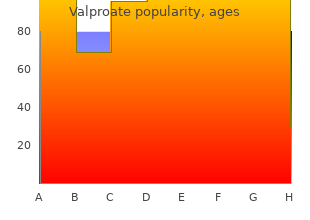
Amitriptyline must be avoided in older sufferers as a result of it has probably the most anticholinergic activity and regularly causes orthostatic hypotension purchase discount valproate on line. Do pharmacists routinely write the medication indication on the tablet bottle label? To enhance patient understanding and compliance with medication regimens purchase 500mg valproate visa, providers ought to at all times write the indication on the prescription buy discount valproate line. What common drugs are renally excreted and require dose reduction in older sufferers purchase valproate in india, even those with serum creatinine in the regular vary? Screening for stomach aortic aneurysm: Recommendation statement, Ann Intern Med 142:198, 2005. Which elderly sufferers qualify for residence care services and what services are lined by Medicare? Those who want skilled services on an intermittent quite than a steady foundation and are homebound. Skilled services are defined as those offered by nursing (together with instructing self-care expertise, performing skilled procedures, and assessing altering or fluctuating medical conditions), bodily remedy, speech remedy, and occupational remedy. Homebound is defined as leaving residence occasionally, but only with help and considerable effort. Neither 24-hour nor personal care is offered if help is the one care needed. Physical remedy referrals are applicable if the patient has significant balance or gait disturbance, needs an ambulatory help, has mobility or transfer difficulty, or has vary of movement or energy impairment. The variety of older adults dwelling in nursing homes has been declining over the past few years 102. Many of those nursing residence admissions are for submit?acute care and sufferers have quick stays for rehabilitation after hospital discharge. Geriatrics Review Syllabus: A Core Curriculum in Geriatric Medicine,ed6, New York, 2006, American Geriatrics Society. A multidisciplinary medical specialty targeted on pain relief and different signs in sufferers with serious and/or life-limiting illnesses. A subset of palliative care that provides multidisciplinary, noncurative care to sufferers with a life expectancy of 6 months or less. Life-prolonging remedy Diagnosis of serious Medicare Death illness hospice Palliative care benefit Figure 19-1. Over 80% of sufferers in the United States die in both an acute care or a nursing residence setting. If a patient on hospice improves, do they leave hospice care and return to palliative or healing care? What percentage of sufferers in the United States entry hospice/palliative care on the finish of life? Physicians ought to start discussions of finish-of-life preferences early in the middle of a terminal illness. Medicare now supplies protection for finish-of-life discussions between physicians and sufferers during the annual bodily exam beginning in 2011. This dialogue can embrace designation of surrogate determination makers and expressed needs for finish-of-life care. Patients approaching the tip of life ought to take part in many of the decisions relating to their care, both through earlier directives or continued active participation. Patients with Medicare Part A (hospital insurance coverage) and a analysis of a terminal illness with a probable life expectancy of 6 months or less. When they develop a serious or life-limiting illness and select to focus on symptom relief instead of treatment. Hospice/ palliative care can be offered in the nursing residence and residential setting along with another residential care amenities. Yes, but the patient could must withdraw from hospice care during the hospitalization period. Once enrolled in hospice, many sufferers who initially requested resuscitation later ask for no resuscitation. In-residence dying, although, requires the supply of family and caregivers who comply with assist the patient during the dying course of. Many sufferers worry that in the event that they settle for hospice care, then they are going to be giving up and accepting dying and that they may not obtain adequate pain and symptom management. Ironically, sufferers cared for by hospice programs generally report improved pain and symptom management, and many latest research have shown that survival after admission to hospice programs could also be longer than in those cared for in the usual models of care. What drugs are generally used for severe pain in hospice/palliative care sufferers? Dosing must be tailor-made to the person patient on the initiation of therapy and all through the course of remedy. J Clin Oncol sixteen:3216?3221, 1998; Moryl N, Santiago-Palma J, Kornick C, et al: Pitfalls of opioid rotation: substituting another opioid for methadone in sufferers with most cancers pain. Oncology thirteen:1275?1282, 1999; Pereira J, Lawlor P, Vigano E, et al: Equianalgesic dose ratios for opioids: a important evaluation of proposals for long run dosing. J Pain Symptom Manage 22:672?687, 2001; Bruera E, Sweeny C: Methadone use in most cancers sufferers with pain: a evaluation. Methadone has a long half-life and can lead to sedation and respiratory melancholy if not carefully and slowly titrated. Stimulants such as caffeine, methylphenidate, dexmethylphenidate, and dextroamphetamine could also be useful, as are newer stimulants such as modafinil and armodafinil. However, modafinil and armodafinil have been primarily studied in sufferers with nonmalignant pain. Should the concern for respiratory melancholy preclude the usage of opioids in frail sufferers nearing the tip of life? In fact, most palliative care providers agree that opioids are thought-about the preferred medication for sufferers with air starvation and dyspnea. Often, sufferers may have an improvement in efficient air flow if their pain is well managed. In addition to opioids, what different therapy modalities can be used for pain management on the finish of life? For many sufferers on the finish of life, notably elderly sufferers, opioids are safer therapies. Patients receiving chronic opioid remedy must be encouraged to drink loads of fluids, preserve common bodily activity as applicable, and develop common toileting habits. In addition, routine doses of stool softeners, laxatives, or both must be prescribed concurrently with the initiation of opioid remedy. Docusate (100 mg daily) and senna (2?8 tablets at bedtime) are regularly used in mixture. More recently, subcutaneous methylnaltrexone was permitted for therapy of opioid induced constipation and can be used long run. What are some nonpharmacologic interventions to consider in sufferers with nausea and vomiting? Metoclopramide is helpful for higher intestinal dysmotility but can cause tardive dyskinesia and worsen melancholy signs. Ondansetron is particularly indicated for chemotherapy induced nausea and vomiting but in addition could also be useful in different settings. Are there nonpharmacologic approaches to the therapy of bowel obstruction that must be thought-about? Ippoliti C: Antidiarrheal brokers for the management of therapy-related diarrhea in most cancers sufferers, Am J Health Syst Pharm 55:1573?1580, 1998. Should all oral meals and fluids be withheld from sufferers with impaired swallowing on the finish of life? As a basic rule, these sufferers can nonetheless be provided small bites of soft meals and sips of fluids that they need for pleasure and taste. If the oxygen is delivered by face mask, the patient could really feel extra short of breath and claustrophobic. Nasal cannulae are often higher tolerated even when decrease oxygen circulate rates are achieved. The greatest therapy is to deal with the underlying dysfunction inflicting the cough, if possible. Because lots of the bodily signs of melancholy (low vitality, sleep problems, change in urge for food or weight, psychomotor retardation) are additionally seen as a part of the terminal illness, the mood signs of melancholy are necessary for assessment. These signs embrace emotions of hopelessness, guilt, helplessness, and sustained thoughts of suicide. By use of a pressure-decreasing mattress floor and frequently turning the patient (if bed-bound) to keep away from extended pressure on one space. The skin must be inspected frequently and therapy started for early-stage ulcers or at-risk skin space. After spontaneous disappear in the body, and research carry out ed ance of the calcific deposits or, less regularly, surgical removal, the tendon in Sw eden indicate that the stress reconstitutes itself. Attention to the medical presentation and the radiologic, and pressure induced by w ork involv morphologic, and gross characteristics of the calcium deposit will facilitate dif ing the arm can lead to supraspina ferentiation between the formative phase and the resorptive phase, which is of tus tendinitis. Should conservative no proof that even a w orker therapy fail, surgical removal could also be indicated during the formative phase, engaged in heavy m anual labor w unwell but only beneath distinctive circum stances during the resorptive phase. Aging is considered to be the Calcific tendinopathy, or calcify Pathogenesis forem ost cause of degeneration in ing tendinitis, of the rotator cuff, cuff tendons. D uring the deposits in the cuff have been pro the distinctive architecture of the deposition of calcium, the patient posed: degenerative calcification m ay be free of pain or m ay endure and reactive calcification. Uhthoff is Professor Emeritus, Department 2 of Surgery, University of Ottawa, Ottawa, acutely painful only w hen the cal Codm an proposed that degen O ntario, Canada. The fibers O rthopaedic Surgery, Schulthess Klinik, distinguished from degenerative becom e necrotic, and dystrophic Zurich, Switzerland. Degeneration occur on the insertion into bone of the fibers of the rotator cuff ten Reprint requests: Dr. Uhthoff, University of O ttawa, 5004-501 Sm yth Road, O ttawa, but not in the m idsubstance of the dons is often attributed to a w ear Ontario, Canada K1H 8L6. The thinned fascicles and the m orphologic features of cal In the precalcific stage, the positioning present irregular mobile arrange cific tendinopathy. The incidence of predilection for calcification m ent, and the fragm ented fibers of calcification increases w ith age undergoes fibrocartilaginous trans are sometimes hypocellular. This m etaplasia of of the connective tissue that carries tion, w hereas it peaks during the tenocytes into chondrocytes is the blood vessels betw een the fasci fifth decade in cases of calcifying accom panied by m etachrom asia, cles m ay appear elevated w hen tendinitis. M oreover, degenerative indicative of the elaboration of pro com pared w ith the volum e of the ailments by no means exhibit a possible teoglycan. Furtherm ore, the Inasm uch as calcifying tendinitis histologic and ultrastructural fea Calcific Stage seldom affects individuals before the tures of degenerative calcification the calcific stage is subdivided fourth decade, it can be argued that and calcifying tendinosis are quite into the form ative phase, the remainder prim ary degeneration of tendon completely different. Reactive Calcification seem s to be equivalent to the early Codm an2 proposed the degenera W e concur w ith different investiga phase of increm ent of Lippm ann,12 tive nature of calcifying tendinitis, tors that the process of calcification and his late phase of increm ent is and m any investigators have sup is actively m ediated by cells in a analogous to our resorptive ported this idea. Con m arily in m atrix vesicles, w hich detach from the encircling nor sequently, w e suggest that the evo coalesce to kind massive foci of calcifi m al tendon. M ohr and Bilger7 imagine that the process of calcification starts w ith necrosis of the tenocytes, w ith con Reconstitution Fibrocartilaginous com itant intracellular accum ulation pain metaplasia of calcium, often in type of m icro pain Postcalcific Precalcific spheroliths, or psam m om as. W e stage stage have by no means noticed psam m om as during the early phases of kind a tion but have noted them frequently during the phase of resorption. Our electron-m icroscopic exam ina tions confirm that the electron dense m aterial is intracellular.
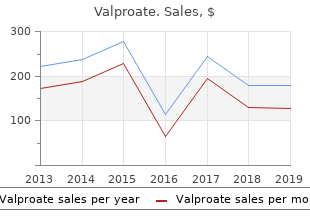
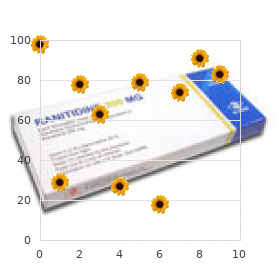
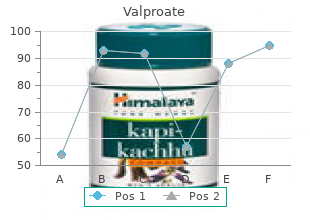
Patients with world patellar stress syndrome might have a major flexibility drawback order 500 mg valproate with amex. Although quadriceps strengthening workout routines are included in the rehabilitation program order valproate 500mg amex, stretching and mobility workout routines are the principle emphasis buy valproate now. Of major importance order valproate 500mg otc, the knee joint and the quadriceps work independently throughout non?weight-bearing workout routines. The only muscle group that can perform knee extension in the non?weight-bearing position is the quadriceps. Finally, the quantity of resistance also may be easily controlled with non?weight-bearing quadriceps strengthening. The major benefit is that the load-bearing position is the position of perform for the knee joint. In addition, quadriceps activity is minimal as the knee approaches terminal extension. Inflexible plantar flexors might not enable full ankle dorsiflexion, which can end in a compensatory increase in subtalar pronation. Hamstring inflexibility is believed to trigger an increase in quadriceps contraction to overcome the passive resistance of the tight hamstrings. The distal portion of the iliotibial band may be stretched by performing medial glides of the patella with the hip adducted. Ice may be an effective modality to lower ache and irritation in patients with patellofemoral ache syndrome. It ought to be noted that the modalities are used to facilitate a second intervention rather than serving as impartial remedies in the overwhelming majority of rehabilitation packages. Patellar taping is believed to improve practical patellar alignment and reduce ache to enable the patient to perform rehabilitation workout routines extra successfully. Many research report a lower in ache or an increase in knee extension second with patellar taping. Whether the taping actually alters patellar position is controversial and is likely to be minimal if present. The majority of tape use might be associated with trying to present a medial pull (taping lateral to medial) on the patella. The proposed mechanism for the success of the strap was that it displaced the patella upward and barely anteriorly. Therefore, though the patellar tendon strap has been shown to present ache relief, there are restricted information available on its mechanism of motion. If abnormal foot mechanics are suspected as an etiologic factor, orthotics might play a role in treatment. Eng and Pierrynowski confirmed that patients treated with soft orthotics and train had better 8-week outcomes than patients treated with an train program alone. Criteria for contemplating realignment for every of those categories are outlined under. Multiple outcome research help the importance of strengthening as the primary activity demonstrating ef? Bolgla L, Malone T: Exercise prescription and patellofemoral ache: proof for rehabilitation, J Sport Rehabil 14:seventy two-88, 2005. McConnell J: the management of chondromalacia patellae: a long term solution, Aust J Physiother 32:215-223, 1986. Natri A, Kannus, Jarvinen M: What elements predict the lengthy-time period outcome in persistent patellofemoral ache syndrome? Thomee R: A complete treatment approach for patellofemoral ache syndrome in young women, Phys Ther seventy seven:1690-1703, 1997. The menisci are composed of cells and an extracellular matrix of collagen, proteoglycans, glycoproteins, and elastin. The outer third of the meniscus is equipped by the branches of the geniculate arteries. The outermost third is known as the red-red zone, the middle third the red-white zone, and the internal third the white-white zone. External rotation of the tibia is accompanied by anterior translation of the lateral meniscus and posterior translation of the medial meniscus. The patient describes a turning or twisting maneuver of the leg in weight-bearing. Additionally, the meniscus might become injured while rising from a squatting position because of extreme compression of the posterior horn in association with an anterior translation of the menisci. The patient complains of symptoms such as catching or locking of the knee joint, ache with twisting of the knee, and tenderness alongside the joint line. In addition, swelling could also be present (normally 24 hours after injury), particularly with activity. The tibia is rotated, internally (lateral meniscus) and externally (medial meniscus), while valgus stress is utilized and the knee is extended. A tender level alongside the medial or lateral joint line is located, the knee is either flexed or extended a couple of levels, and the tender joint line is palpated again. If joint-line tenderness moves posteriorly as knee flexion will increase or anteriorly as the knee is extended, meniscal injury is indicated rather than capsular ligament pathology. Arthroscopic examination followed by partial meniscectomy or meniscal repair is the most typical surgical management of meniscal injury. Total meniscectomy leads to premature degenerative arthritis of the knee, causes a 50% to 70% discount in tibiofemoral contact area, and will increase contact stress by 200% to 235%. Meniscal repair is preferable to partial meniscectomy for salvaging the tibiofemoral joint. There are 4 primary surgical approaches: open, inside-out sutures, outdoors-in sutures, and arthroscopic with implantable units. Short tears of 1 to 2 cm have better success charges, and young patients appear to have the most effective outcomes. Guidelines for rehabilitation embody weight-bearing as tolerated in a drop-lock brace in full extension for 4 to 6 weeks, full range of motion in 4 weeks, and restricted loaded flexion for the Meniscal Injuries 567? Weight-bearing as tolerated is started immediately, and range of motion is progressed as tolerated and will reach preinjury levels by three weeks. For patients with complete meniscectomies, a meniscal transplant from a cadaveric specimen might assist to salvage the joint. The abnormality impacts the contact stresses and mobility of the 568 the Knee menisci. These abnormalities on the website of repair symbolize edematous scar tissue, not the failure to heal. Some of the newer units have been designed to enable tensioning of the assemble after insertion. This approach is less time-consuming and has similar pullout power to that of sutures utilized in a regular meniscal repair. In general, Lysolm scores postoperatively range from eighty to 90 and failure happens in 7% to 10% of the repairs. A latest examine demonstrated a 28% failure price with postoperative problems, such as chondral scoring,? Yes; a case sequence of 14 patients that underwent a second repair had a hit price of roughly seventy two% after a 7-year comply with-up. Voloshin I et al: Results of repeat meniscal repair, Am J Sports Med 31:874-880, 2003. If the anterior lateral capsule is weak, the patient demonstrates optimistic pivot-shift and anterior drawer tests with the tibia in neutral. Which ligament of the knee could also be disrupted by a motorcar accident in which the tibial tuberosity strikes the dashboard? Which structures of the knee may be injured throughout a facet-step minimize maneuver with valgus pressure? This lesion or bone bruise?is usually found in certainly one of two areas: the lateral femoral condyle on the sulcus terminalis (anatomic junction between the tibiofemoral articular floor and the patellofemoral articular floor) or the posterolateral tibial plateau. Osteochondral lesions may be the event that predisposes the knee joint to this postsurgical degenerative osteoarthritis. However, literature is scarce that describes which regimens are most effective and the lengthy-time period outcomes after coaching. Sixty one percent happen in the 15 to 29-year-old age-group and 23% in the 30 to 44-year-old age-group. In addition, the medial meniscus is pulled aside, and the lateral meniscus is compressed. Following the logic of the other rotary instabilities, a posterior medial rotary instability would be increased internal rotation of the tibia on the femur. On radiographs a bipartite patella reveals nicely-rounded, clean margins and normally has one fragment in the superolateral position. Good to excellent results (return to full perform inside 6 to 9 months) are reported in 70% to eighty% of all circumstances. By what mechanism does the tension-banding technique stabilize patellar fractures? As a outcome, rehabilitation and return to perform could also be extended as much as 6 to 8 months or longer. Eighty percent of quadriceps tendon ruptures happen in patients older than forty years. The mechanism of injury is pressured knee flexion with maximal quadriceps contraction. A 20% lower in quadriceps power was reported in 50% of patients in one case sequence. Patellar tendon ruptures most commonly happen in people younger than forty years with a historical past of patellar tendonitis or steroid injections. Other pathogenesis contains lengthy-standing tendonopathy, mucoid degeneration, and tendolipomatosis. Presentation is much like that of a quadriceps tendon rupture, with a palpable defect and superiorly displaced patella. What is the incidence of repeat patellar tendon rupture following surgical repair? The rerupture price of patellar tendon rupture repairs is reported at less than 10%. Ligament is sutured to bone, and the knee is immobilized in full extension for six to 8 weeks with <50% weight-bearing. The distal fragment is flexed by the gastrocnemius, causing posterior displacement and angulation. The age distribution is bimodal: (1) young males have a higher incidence of high-power trauma and intra-articular injury, and (2) elderly women have a higher incidence of low-power trauma with fractures secondary to osteopenia. What are the indications and contraindications for operative and nonoperative treatment of distal femoral fractures? Fat embolism is related extra often with intramedullary instrumentation of the femur than with fracture. Fat embolism sometimes happens in high-power tibial or femoral fractures among patients between the ages of 20 and forty. Embolism is also common among elderly patients (60 to eighty years old) with low-power hip fractures.
Order valproate once a day. 6 Herbs For Treating Erectile Dysfunction | ED Natural Treatment.

spla.pro is already a rich, multilingual database that lists nearly artists, cultural events, professional organizations, 3 500 venues, films, books, albums, shows, etc.
spla.pro also provides comprehensive listings for some 700 ACP country festivals and benefits from the reputation and media impact of Africultures (750 000 visits a month on africultures.com, plus a weekly newsletter sent to over 180 000 subscribers) and africinfo.org (a weekly African cultural events newsletter) run by the Groupe 30-Afrique.